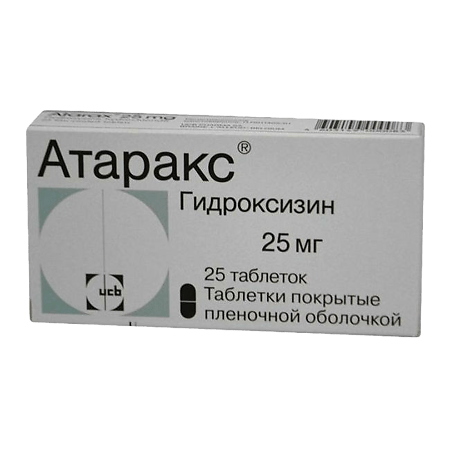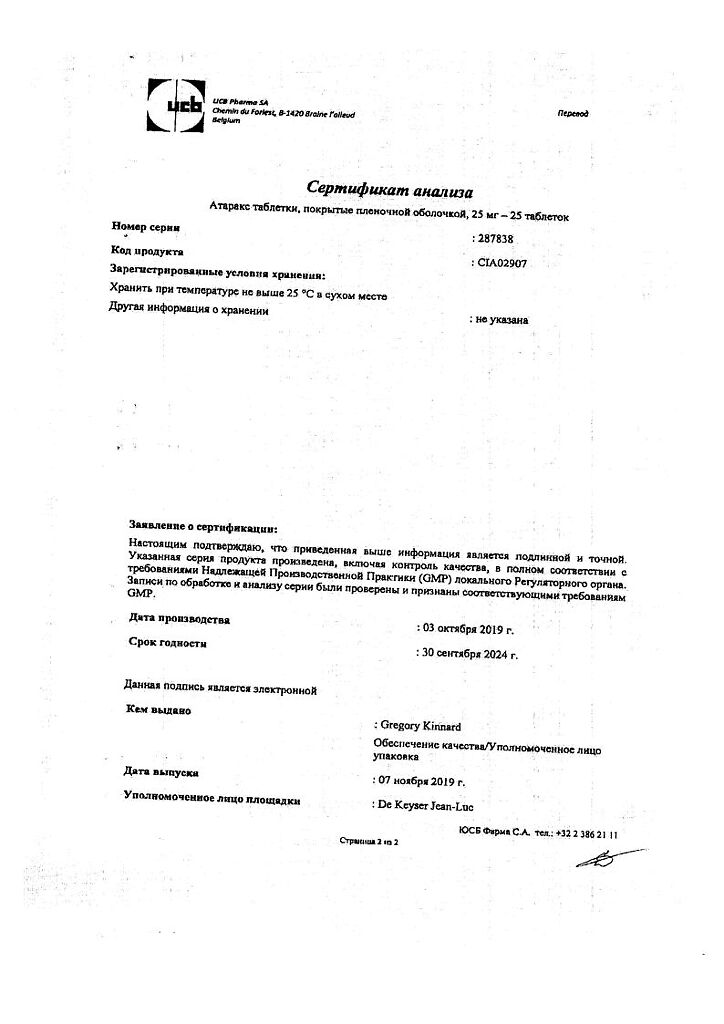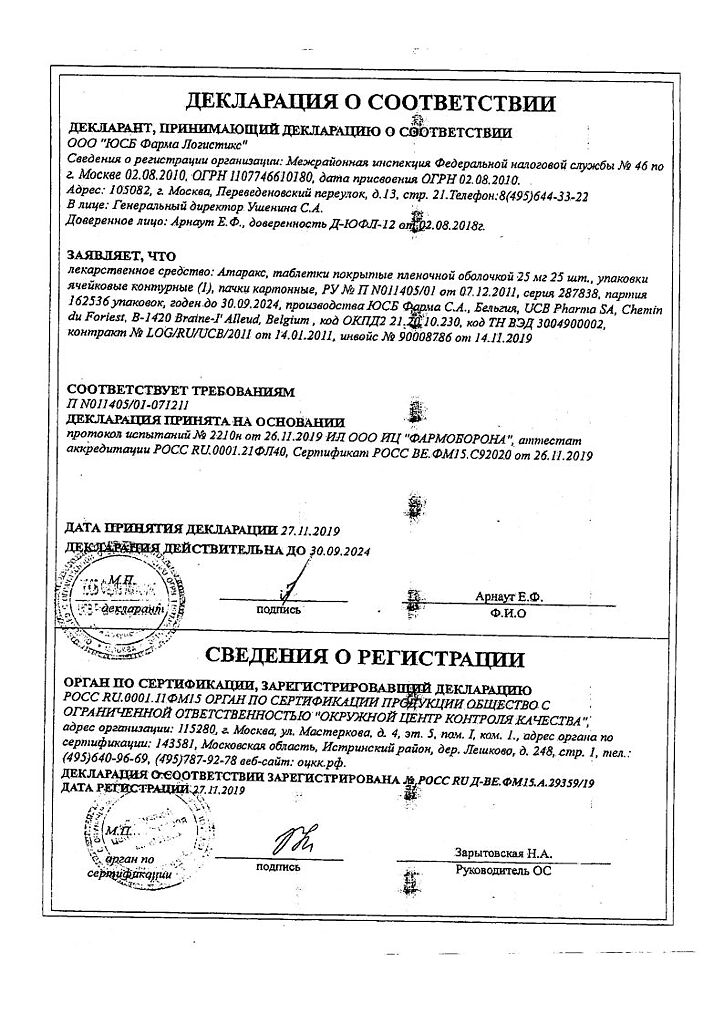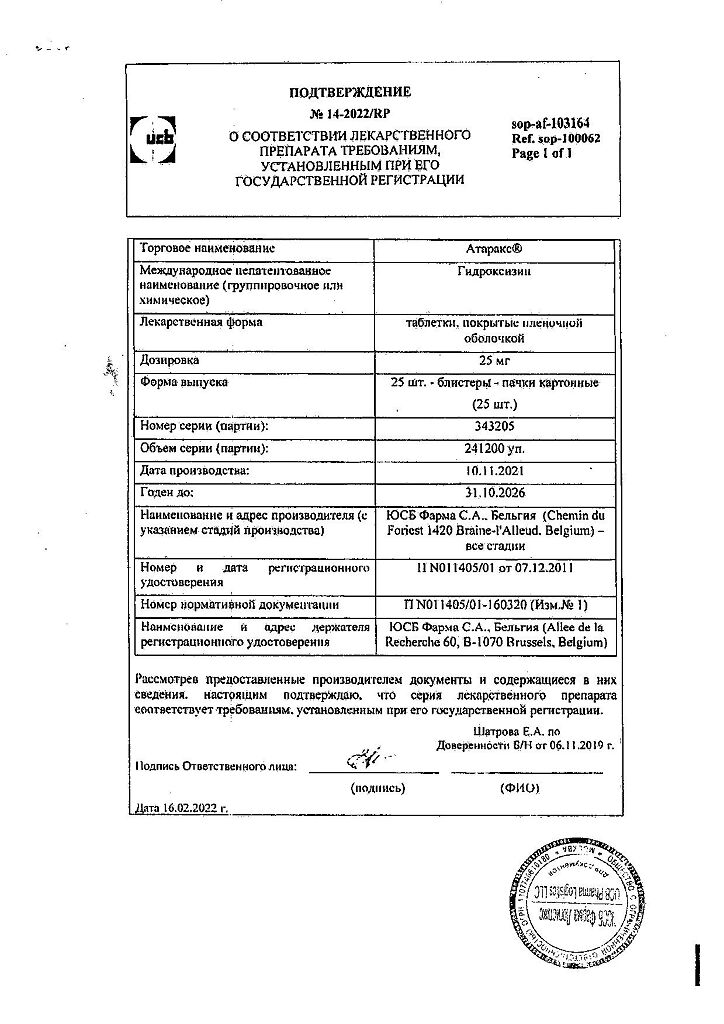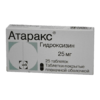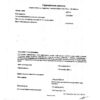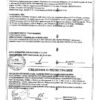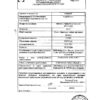No products in the cart.
Atarax, 25 mg 25 pcs
€6.99 €5.55
Description
Pharmgroup:
Anxiolytic agent (tranquilizer).
Pharm Action:
The diphenylmethane derivative has moderate anxiolytic activity; also has sedative, antiemetic, antihistamine and m-cholinoblocking effects.
Blocks central m-choline and H1-histamine receptors and inhibits the activity of certain subcortical areas. It does not cause psychic dependence and addiction. Clinical effect occurs 15-30 min after ingestion of the tablets. It has a positive effect on cognitive abilities, improves memory and attention. It relaxes skeletal and smooth muscles, has bronchodilator and analgesic effects, a moderate inhibitory effect on gastric secretion. Hydroxyzine significantly reduces itching in patients with urticaria, eczema and dermatitis.
With long-term use, no withdrawal syndrome and cognitive deterioration have been noted. Polysomnography in patients with insomnia and anxiety clearly demonstrates a prolongation of sleep duration, a decrease in the frequency of nocturnal awakenings after taking hydroxyzine once or repeatedly at a dose of 50 mg. A decrease in muscle tension in patients with anxiety was noted when taking the drug in a dose of 50 mg 3 times a day.
Indications
Indications
– Adults to relieve anxiety, psychomotor agitation, feelings of inner tension, increased irritability in neurological, psychiatric (generalized anxiety and adaptation disorder) and somatic diseases, as well as in chronic alcoholism, alcohol withdrawal syndrome accompanied by symptoms of psychomotor agitation;
– as a sedative in premedication;
– symptomatic therapy of pruritus.
Active ingredient
Active ingredient
Composition
Composition
1 tablet:
– hydroxyzine hydrochloride 25 mg
Associates:
microcrystalline cellulose (Avicel PH102®),
colloidal silicon anhydride (Aerosil 200®),
Magnesium stearate,
Lactose monohydrate,
Opadray® Y-1-7000 (titanium dioxide, hydroxypropyl methylcellulose 2910 5cP, macrogol 400).
How to take, the dosage
How to take, the dosage
Internal.
In children: for symptomatic treatment of pruritus. At the age of 12 months to 6 years – 1 to 2.5 mg/kg/day of Atarax in several doses, from 6 years and older – 1 to 2 mg/kg/day in several doses.
For premedication, 1 mg/kg 1 hour before surgery, and additionally the night before anesthesia.
Adults: for symptomatic treatment of anxiety, 25-100 mg daily in separate doses during the day or at night. The standard dose of Atarax is 50 mg daily (12.5 mg in the morning, 12.5 mg in the afternoon, and 25 mg at night).
In serious cases, the dose may be increased to 300 mg per day.
For premedication in surgery, 50-200 mg (1.5-2.5 mg/kg v/m) is given 1 hour before surgery.
For symptomatic treatment of pruritus, the initial dose is 25 mg; if necessary, the dose may be increased 4-fold (25 mg 4 times daily).
In elderly patients treatment is started with half dose of Atarax. In case of renal and/or hepatic insufficiency the doses should be reduced.
The single maximum dose should not exceed 200 mg, the maximum daily dose should not exceed 300 mg.
Interaction
Interaction
Atarax® potentiates the effect of CNS depressant drugs such as opioid analgesics, barbiturates, tranquilizers, sleeping pills, ethanol (in combinations individual selection of doses of drugs is required).
Atarax® with concomitant use interferes with the pressor effect of epinephrine (adrenaline) and anticonvulsant activity of phenytoin and also interferes with the effect of betahistine and cholinesterase blockers.
When used concomitantly Atarax® has no effect on the activity of atropine, belladonna alkaloids, cardiac glycosides, hypotensive agents, histamine H2-receptor blockers.
The co-administration of Atarax with MAO inhibitors and choline blockers should be avoided.
Hydroxyzine is an inhibitor of the CYP2D6 isoenzyme and may cause interactions with CYP2D6 substrates when used in high doses. Since hydroxyzine is metabolized in the liver, an increase in its blood concentrations can be expected when co-administered with hepatic enzyme inhibitors.
Special Instructions
Special Instructions
If it is necessary to perform allergic tests, Atarax should be discontinued 5 days before the study.
Because hydroxyzine may affect attention and psychomotor reactions, patients should be warned about this when driving and operating machinery.
Contraindications
Contraindications
Hypersensitivity to any of the ingredients of Atarax, cetirizine and other piperazine derivatives, aminophylline or ethylenediamine;
porphyria;
pregnancy;
childbirth;
breastfeeding period.
hereditary intolerance to galactose, impaired glucose-galactose absorption (because the tablets contain lactose).
With caution: myasthenia gravis; prostatic hyperplasia with clinical manifestations, including
With caution: myasthenia gravis; prostatic hyperplasia with clinical symptoms, including difficulty urinating; constipation; increased intraocular pressure; dementia; susceptibility to seizures; patients prone to arrhythmias or who receive medications that can cause arrhythmias; patients simultaneously treated with other CNS depressants or choline blockers (dose must be reduced); Patients with severe and moderate degree of renal insufficiency, as well as with hepatic insufficiency (dose should be reduced); elderly patients (dose should be reduced if glomerular filtration is decreased.
Side effects
Side effects
The effects are mild and transient, usually disappearing after a few days of treatment or after dose reduction.
Side effects are mostly associated with CNS depression or paradoxical CNS stimulating effects, anticholinergic activity, or hypersensitivity reactions.
Anticholinergic effects: dry mouth, urinary retention, constipation, or impaired accommodation are rare and mostly seen in elderly patients. Drowsiness and general weakness may occur, especially at the beginning of treatment with the drug. If these effects do not disappear after a few days of therapy, the drug dose should be reduced.
There have been reports of other side effects such as headache, dizziness, increased sweating, arterial hypotension, tachycardia, allergic reactions, nausea, fever, changes in liver function tests, and bronchospasm. No clinically significant respiratory depression has been noted with the recommended doses.
Involuntary motor activity, including very rare cases of tremors and convulsions, disorientation have been observed in significant overdose.
Overdose
Overdose
The manifestation of overdose of Atarax may be a pronounced anticholinergic effect, depression or paradoxical stimulation of the CNS.
Symptoms (in case of significant overdose): nausea, vomiting, involuntary motor activity, hallucinations, impaired consciousness, arrhythmia, arterial hypotension.
Treatment: if spontaneous vomiting is absent, immediate gastric lavage and inducing vomiting by artificial means is recommended. General supportive measures are indicated, including control of vital body functions and monitoring of the patient until symptoms of intoxication disappear and in the following 24 h. If a vasopressor effect is necessary, norepinephrine or metharaminol should be administered. Epinephrine should not be administered. Hemodialysis is not effective. There is no specific antidote.
Similarities
Similarities
Additional information
| Weight | 0.020 kg |
|---|---|
| Shelf life | 5 years |
| Conditions of storage | In a dry place, at a temperature not exceeding 25 °C |
| Manufacturer | UCB Farma, Belgium |
| Medication form | pills |
| Brand | UCB Farma |
Related products
Buy Atarax, 25 mg 25 pcs with delivery to USA, UK, Europe and over 120 other countries.

